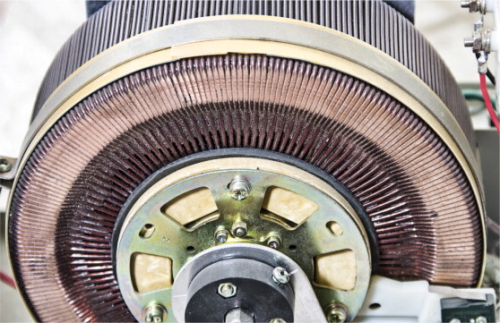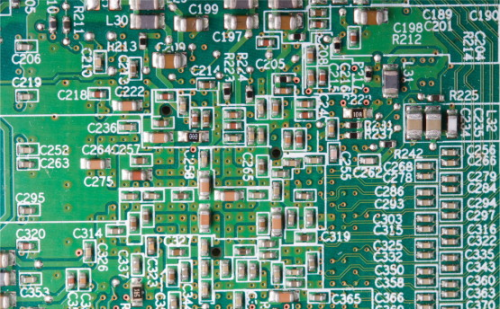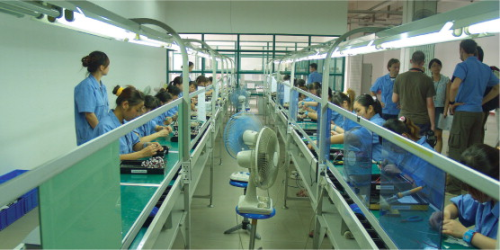



There are two markedly different industrial sectors to be covered in this final article of a ‘small sector series’, these being the manufacture of electrically powered equipment for industrial, commercial and domestic use, and the production of electronic materials, in particular the semiconductor devices that are at the heart of everything from a desktop computer to an aircraft.
The electrical equipment component involves the following sub-sectors:
• the manufacture of light and heavy electrical equipment, such as transformers, generators, and their associated cabling, including standby generators;
• domestic and commercial ‘white goods’ (refrigerators, freezers, etc), ovens, and counter-top items such as toasters and grills;
• other domestic and commercial devices such as suction cleaners, carpet shampooers;
• office equipment and computers of all kinds, including laptop and hand-held devices;
• all types of audio-visual equipment, such as radio and television, sound systems and music players;
• telephone exchange equipment and all kinds of local telephones, including the mobile phone in all of its variants; and
• precision electrical instruments, satellite navigation devices, and so on.
(The large-scale equipment, apart from the generators, used to produce electricity in power stations, whether fossil-fuel or nuclear powered, have been considered separately as part of the Power Generation sector, as have wind turbines, and tidal and wave power generators.)
The other half of this sector covers not equipment but materials, in that it deals with the manufacture of semiconductor devices of all kinds, to control not just the desktop computer but also all systems needing electronic control, and the production of electromagnetic recording materials such as tapes, discs, and camera and phone cards.
From the point of view of the filtration and separation equipment market, this sector has then these two very different components: the manufacture of equipment on the one hand, which is very similar in requirements to the manufacture of mechanical machinery, and the manufacture of semiconductors and recording materials on the other, whose operations are very different to those of machinery manufacture, being more akin to those of the pharmaceutical industry. Whilst standards of manufacture are quite high in the provision of electrical equipment, they are very much higher in the semiconductor business.
Electrical equipment manufacture
As far as the manufacture of heavy electrical goods and domestic white goods is concerned, there is very little demand for filters or other separation equipment for inclusion in the products of its main processing lines (apart from their use in transformer oil recycle systems). However, it has need of the full range of mechanical manufacturing utility requirements of compressed air, pneumatic and hydraulic systems, and machine tool coolant recycle.
These utility applications are quite small in volume terms, compared with other applications, but they are vital to the manufacturing process, in keeping it running. Both hydraulic and pneumatic systems rapidly become contaminated with dust, and corrosion and erosion products, which have to be filtered out of suspension to ensure the continued safe operation of the associated equipment. The same is true of the cooling and lubricating systems used in running machine tools, to remove metal or plastic shavings. In all such applications, the demand continues for finer degrees of filtration, to meet increasing needs for precision in the manufacture.
The one important case where filters are part of the finished product is in the manufacture of transformers, where a cooling oil circulates around the coils, and needs to be kept clean. This is often done on a side-line cleaning circuit, since the rates of attrition and oil breakdown producing contaminants are not high. A feature of this application is the need to be able to operate for long periods unattended.
Semiconductor production
The production of electronic materials such as semiconductors, recording tapes, memory chips, etc, requires an exceedingly clean environment, so that working space, ambient air and all washing and cleaning liquids have to be absolutely as clean as possible. The manufacture of electrical equipment and electronic components has always required a fairly clean environment, but this has become very much more so in the modern semiconductor fabrication plant, to the extent that the working space is now as much in need of cleaning as is any input material or processing fluid.
The fabrication of semiconductor devices is undertaken in the same sort of clean room as is pharmaceutical production, but with the additional requirement that incoming contamination (on people, in the air that comes in whenever a door is opened, and so on) is as important to prevent as any exhaust from the working space.
The critical feature of a semiconductor device is the size of the individual components created on the surface of the basic semiconductor material. In the early 1970s this critical size was 10 μm, but now it has reduced almost to 10 nm. The size decrease with time has followed Moore's law (which actually states that the number of transistors that can be placed inexpensively on an integrated circuit has doubled approximately every two years), and the important factor as far as semiconductor manufacture is concerned is that a speck of dirt of a size comparable with this critical dimension is capable of rendering the device faulty.
The standard semiconductor begins as a monocrystalline ingot of very pure silicon, up to 300 mm in diameter, which is then sliced into very thin circular wafers. These wafers are washed and polished, and then undergo a series of processes, sometimes as many as 300 steps altogether, in which material is deposited on the surface from the last process, by means such as vapour deposition, or etched free of material in places, or treated to impose a shield on some areas to stop those areas from being etched, and so on. Some of the process fluids are extremely aggressive, but all have to be filtered clear of unwanted solid particles, and the wafers being treated usually have to be washed after each step, with ultrapure water.
The fluids in use in these processes have usually been extensively treated to produce them to their required specification, which makes them expensive, such that their recycle is an important part of the process economics, and filters have as important a part to play in the recycle system as they do in the initial production.
The marketplace
There are many companies trading within the electrical and electronic equipment and materials categories of business, with GE (based in the USA) probably the largest, in terms of its 2009 sales (of over $150 billion), although it covers many other business sectors as well, especially water. Next in size of the general electrical and electronic companies comes Siemens (of Germany), which is also investing heavily in water. Other leading companies include Hewlett Packard, Samsung and Hitachi. The largest ‘pure’ semiconductor fabricator is Intel, with Taiwan Semiconductor and AMD also large fabricators.
The total world market for filtration and related separation equipment, in the electrical and electronics sector, is estimated to have been in the region of $1.7 billion in 2009, representing a share of just over 3.5% of the nearly $49 billion global market. The 2009 market size was only a little greater than that for 2008 (and was actually less in real, uninflated terms), showing the effect of the 2008/2009 recession – this to be compared with a market size growth of close to 7% in 2007.
The market in 2010 is expected to increase by about 4% in real terms over the 2009 value, and this market will then increase by factors rising to around 7% again by 2013.
The electrical machinery market was hit quite badly by the recent downturn, and, whilst starting to grow again, is doing so only slowly. Semiconductor production is recovering more rapidly, despite the change from desk top computer to portable versions, largely driven by the inclusion of computers in so many other products.
Equipment involvement
Apart from the utility filtration needs involved in electrical equipment manufacture, there are the two main separation duties in electronic materials manufacture:
• the cleaning of inlet air to the working spaces and fabrication areas to a high standard of freedom from dust, and the similar filtration of exhaust air streams to protect the surrounding environment; and
• the preparation of ultra-pure water for component washing and to make up wafer processing fluids, and the preparation of these liquids.
The demands on the appropriate separation equipment are becoming steadily greater, and the suppliers continually need to develop more efficient nonwoven media and membranes, especially for filters for water to meet these demands.
The electrical machinery manufacturing component has a low level of use for process filtration equipment in its main operations, but a relatively large use in its ancillary, or utility, operations, such as the relatively simple filters required to keep hydraulic and pneumatic systems free of dirt. The production equipment will use cooling fluids and lubricants in its machine tools, and these fluids have become quite complex, and therefore expensive, formulations. Their recycling has become essential, involving increasingly complex filtration systems or the use of centrifuges.
As has already been described, the production of electronic materials such as semiconductors, recording tapes, memory chips, etc, requires an exceedingly clean environment, so that working space air and all washing, cleaning and processing liquids have to be absolutely as clean as possible.
Air filtration is needed to clean incoming air to the clean room, to decontaminate the air circulating through the working spaces, and to filter any process or emergency vents from the clean rooms to the outside air. High grade ventilation filters, of the panel type, are now routine fitments for such places, with HEPA and ULPA grades now commonplace. Another growing need is for the combination filter, which adsorbs noxious gaseous components as well as removing suspended solids, especially for exhaust vent applications.
Process and washing water for use in semiconductor fabrications begin as mains supply drinking quality water, and submit this to a series of filtration steps, almost without exception now using ultrafiltration as the basic treatment step, and, as the processing requirements (i.e. the filtration cut-point) get into the region of tens of nanometres, these will increasingly use nanofiltration. The semiconductor fabrication industry is thus a large user of membrane processes, which are required not only to remove contaminants at the very lowest levels to maintain manufacturing efficiency, but also to do so in the frequently corrosive environments of the processing liquids.
Market prospects
One of the key impacts of environmental pressures on this sector is the slow movement away from the petrol or diesel driven internal combustion engine, towards the use of electricity as a vehicle motive power. Should this occur in large proportions, then it will have a significant effect upon the electrical equipment sector, with an increased demand for electric motors and fuel cells. Because of its ease of control in use, the electrically driven machine, of all kinds. will continue to be in great demand, especially in the developing world as it increases its standards of living.
The semiconductor will go on reducing in size, for the next few years at least, with correspondingly increased demands on its manufacturing processes. Just as certain, therefore, is the continued demand for better operating performance placed upon the filters used in semiconductor fabrication plants. This means not just finer filtration, but also the ability to withstand the ever widening range of corrosive fluids. The working spaces in which semiconductors are made are controlled by the Restriction of Hazardous Substances (RoHS) Directive of the EU. At present this restricts emissions of six substances (lead, mercury, cadmium, chromium in its hexavalent form, and two groups of brominated organic compounds), but the list can be expected to get longer, increasing the controls – and hence the process filtration requirements.





